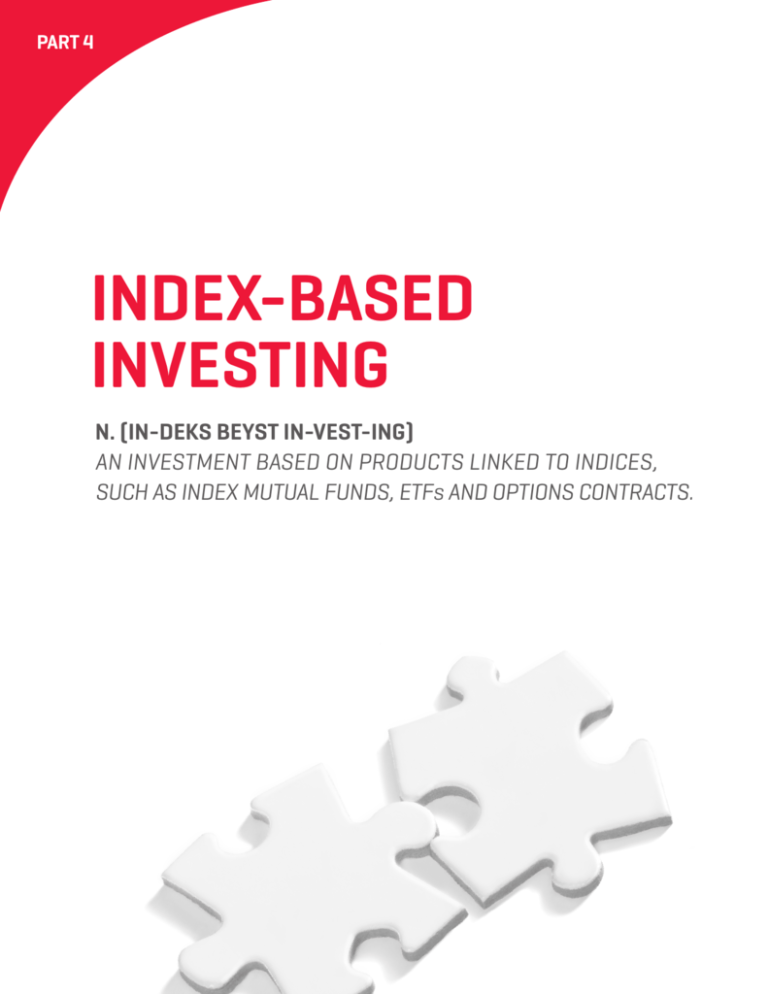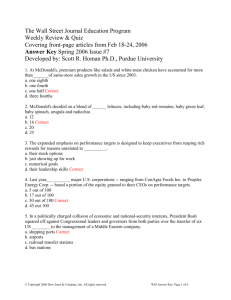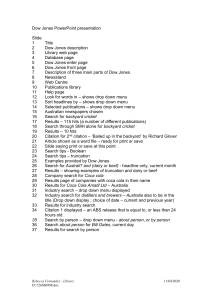
PART 4
INDEX-BASED
INVESTING
. (IN-DEKS BEYST IN-VEST-ING)
N
AN INVESTMENT BASED ON PRODUCTS LINKED TO INDICES,
SUCH AS INDEX MUTUAL FUNDS, ETFs AND OPTIONS CONTRACTS.
1
INDEX-BASED INVESTING
Index-based investing has revolutionized the way investors access
financial markets and participate in market performance. It was an idea
that was radical when John Bogle launched the first index mutual fund
in 1976.
There are good reasons for index-based
investing’s unique appeal. It can provide
portfolio diversification and transparency, so
investors may know what is owned. Thanks to
the variety of index-linked products, investors
can participate in multiple financial markets
in the world,
broad or
Thanks to the variety of
narrow. It’s
index-linked products,
possible
to build a
investors can participate
portfolio
in virtually every financial
of indexmarket in the world,
linked
broad or narrow.
products
with
widely varying
objectives, investment style, and/or risk
tolerance. The risks taken, as well as the
returns realized, will correspond to the risks
and return of the markets in which one
invests. However, it should be noted that index
returns do not reflect expenses investors
would pay to purchase or hold index-based
products. Not only does index-based investing
offer a simpler approach to investing, it’s less
costly than actively managed investing as well.
But what, exactly, is index-based investing
(sometimes called “passive investing”)? It’s
not, as the term may imply, investing directly
in an index. That’s because an index isn’t an
investment. It is a measure of securities or
other assets in a specific market. Indices
can and do, though, serve as the basis for
investment products, such as index mutual
funds, exchange-traded funds (ETFs), and
options contracts.
The index to which an index product is linked
determines that product’s portfolio. For
example, an ETF linked to the Dow Jones
Industrial Average® holds the 30 stocks in that
index and seeks to match its performance.
That’s a key difference between index-based
investing—which is described as passive
management—and active management. Using
an active approach, managers subjectively
select securities in an attempt to beat their
benchmark indices.
ACTIVE MANAGEMENT has two chief limitations
that don’t apply to passive investing.
COST: It’s typically expensive to
compensate active managers and to
pay for the frequent trading costs of
their buy and sell decisions.1
RESULTS: Most active managers
fail to outperform the market over
the long term.2
William F Sharpe, “The Arithmetic of Active Management,” in the Financial Analysts’ Journal, 1991 (cited in Craig
Lazarra Indexology blog March 10, 2014).
2
SPIVA US Scorecard, 2013, bullet # 2 (reaffirmed in more recent SPIVA results and frequently cited).
1
2
Index-based investing is considered to have the
following characteristics:
3
DIVERSIFICATION
TRANSPARENCY
MARKET RETURN
COST EFFICIENCY
PART 4: BENEFITS OF INDEX-BASED INVESTING
Diversification
A diversified portfolio holds a large number
of securities that react differently to changes
in the economy or market environments. For
example, some stocks typically outperform the
broader market when the economy is booming,
but underperform when it slows down. The
value of other securities may not be seriously
hurt by a downturn or boosted by an upturn. A
diversified equity portfolio holds some of each.
As a result, diversification typically provides
greater protection against market risk than
owning a limited number of stocks or other
securities. When a portfolio is sufficiently
diversified, assets that are strong at any given
time can help offset losses in those that may
be losing value. The more diversification there
is, the greater the potential mitigation of risk in
the event of market loss.
The impact of diversification, which is the
foundation of modern portfolio theory,
was explained by the Nobel Prize-winning
economist Harry Markowitz. He concluded
that the “perfect portfolio” was the whole
stock market because it provided the greatest
diversification.3 But until Vanguard opened
the first index fund4 more than 20 years after
Markowitz’s groundbreaking work, it just wasn’t
feasible for individual investors to attain such
market diversification.
Today, a portfolio of index-linked products can
provide exposure to broad markets either locally
or globally. This means investors can come very
close to owning the portfolio that Markowitz
described. Even within a more narrowly defined
market, such as an industry or sector, some
investors use diversified index products to lower
risks relative to investing in individual securities.
Transparency
An ETF or index-linked mutual fund seeks to
replicate the performance of the market its
underlying index tracks, either by owning all
the securities in that index or a representative
sample. Risk that the ETF or fund will stray far
from its stated objective is limited. That can
happen, however, with an actively managed
fund if the fund buys stocks that aren’t
consistent with its investment approach, but
are selected to bolster its return. The result
of this approach, described as style drift, may
expose an investor to more risk than they’re
comfortable taking or to less risk than they’re
willing to assume to meet investment goals.
Transparency means knowing not only what
the ETF or index fund owns but also in what
proportion. With index investments, this
information is typically publicly available every day.
Actively managed funds, on the other hand, are
required to report their holdings just four times
a year. Between quarterly filings, these funds
can hold any
securities
Some investors use
and in any
proportion,
diversified index products
so it’s entirely
to lower risks relative
possible for
to investing in
funds with
individual securities.
very different
objectives to
own a number
of the same securities without making that
information public. For an investor, this can
potentially result in duplicative holdings and
a loss of diversification, which may increase
investment risk.
Markowitz: Harry Markowitz, “Portfolio Selection,” in Journal of Finance, 1952.
Vanguard fund: The fund opened in 1976. The point that individual investors had not access to a broadly diversified portfolio before
the Vanguard fund is made in Burton Malkiel, A Random Walk Down Wall Street, now in 11th edition, originally published 1973.
3
4
PART 4: BENEFITS OF INDEX-BASED INVESTING
4
Market Return
Indices are designed to mirror the risk and
return characteristics of the markets they
measure through a representative sample
of the underlying assets. Index-linked
investment products, therefore, can be a
convenient means of capturing specific
market performance.
What’s more, it’s widely recognized that
securities markets, especially those in
developed economies, are highly efficient.
Efficiency, in this context, means that:
EXISTING MARKET INFORMATION
is readily and inexpensively available
and incorporated in security prices.
NEW INFORMATION about a security occurs
randomly and is thus unpredictable.
The EFFECT of any new information on a
security’s price is equally unpredictable.
Ultimately, market efficiency means that
there are few opportunities to exploit
information that may impact the behavior of
individual securities or the broader markets.
This information is already priced into the
markets and is
reflected in the
performance of
A well-diversified portfolio
indices and the
has historically risen
index-linked
over the long term.
products that
track them.
Of course, no investment strategy, including
a passive approach, guarantees a positive
return. But a well-diversified portfolio has
historically risen over the long term. U.S.
equity prices, for example, have maintained
an upward trend as demonstrated by the
historical performance of the S&P 500®
and The Dow®. Index-based investing is an
approach designed to help investors capture
this market return.5
Cost Efficiency
The price paid to buy and own an investment
reduces its potential return. The higher the
investment cost, the greater the drag
on performance.
fees for administration and investment
management. Trading costs are the fees
that a fund pays to buy and sell securities
for its portfolio.
Two key measures of investment cost
are expense ratios and trading costs. An
expense ratio is the amount, expressed as
a percentage of the account’s value, that is
regularly subtracted from its return to cover
An expense ratio is public information. It can
be found in an investment’s prospectus, in a
variety of online sources, and in the financial
press. Given the passive nature of indexbased investments. Index funds and ETFs tend
5
5
Interviews with members of the Index Committee, including David Blitzer, Craig Lazarra, and others in January 2014.
PART 4: BENEFITS OF INDEX-BASED INVESTING
to have lower expense ratios than actively
managed funds. In 2012, for example, actively
managed equity funds had, on average, an
expense ratio of 0.92% while the comparable
expense ratio for equity index funds was only
0.13% (Source ICI, 2013). Expense ratios do
vary by investment objective, however, and are
often higher for small-cap funds, international
funds, and those with more specialized
objectives. It’s often more costly to own an
actively managed investment with a particular
objective than a passive investment with the
same objective.
One reason for this difference in cost may be
that passive manager compensation tends
to be less costly than active managers. In
addition, there’s more money in the average
equity index fund (USD 1.7 billion) than in
the average actively managed fund (USD
393 million), and economies of scale help to
reduce costs (Source ICI, 2013).
Trading fees, another contributor to investment
cost, are not included in a fund’s expense ratio
or reported separately. To estimate what a
fund spends on trading, its turnover rate must
be known. That’s the percentage of the fund’s
portfolio that’s replaced during a year. The
greater the turnover, the higher the trading
costs. On average, the turnover rate for an
actively managed equity mutual fund in 2012
was 62%, or more than half of all fund holdings
(Source: ICI 2013). A fund that turns over half
or more of its portfolio in the course of a year is
likely to generate substantial short-term gains,
with resulting tax consequences.
Index funds and ETFs tend to turn over their
portfolios only when there is a change in the
underlying index—sometimes just a few times
a year or even less frequently. In fact, many
indices are constructed specifically to limit
turnover.
Eugene Fama—the Nobel Prize winner often
described as the father of index investing—
pointed out that this combination of factors
makes it extremely difficult, if not impossible,
for active managers to outperform an efficient
market or the indices that track it. According
to Fama, to gain any advantage in securities
selection,
managers
would have
It’s often more costly to
to predict
own an actively managed
correctly,
over and
investment with a
over again,
particular objective than
what new
a passive investment with
information
might
the same objective.
emerge
about a
security and
how the security’s price might be affected
as a result.6 Years of statistics generated by
S&P Dow Jones Indices Versus Active Funds
(SPIVA®) studies, confirm the challenge
active managers face. Few active managers
outperform their relevant benchmark index
in any given year, and virtually none do it
consistently.
Eugene Fama: Eugene Fama, “The Behavior of Stock Prices,” rewritten as “Random Walks in Stock Market Prices,” in
Financial Analysts’ Journal, 1965, and in “Efficient Capital Markets: A Review of Theory and Empirical Work, in Journal of
Finance, 1970.
6
PART 4: BENEFITS OF INDEX-BASED INVESTING
6
INDEX-LINKED PRODUCTS
In his groundbreaking guide to investing,
A Random Walk Down Wall Street, first
published in 1973, Burton Malkiel argued for
the creation of a no-load, low-fee mutual
fund. This type of fund would give investors
access to market return, or beta, by buying
the component stocks of a market index and
making no effort to outperform the index.
Just three years later, in 1976, Bogle’s
index fund was launched, providing what he
described as broad diversification at relatively
low cost. ETFs followed in 1993, adding more
trading flexibility, greater tax efficiency and
a larger opportunity set, or the range of ways
index products can be used to fulfill different
investment strategies.
As evidence of the increased popularity of
index products, as of 2013, U.S investors had
about USD 1.7 trillion invested in index mutual
funds, one-third of it in funds linked to the
S&P 500, and more than USD 1.3 trillion in
ETFs (Source: ICI, 2013).
The universe of index products was also
enlarged by the introduction of index-linked
futures contracts in 1982 and options
contracts in 1983. These products, while
different from each other in some important
ways, both are used:
HEDGE an equity or bond portfolio against
the risk of a falling market
GENERATE income
GAIN broad market exposure with less cost
and difficulty than buying all the securities
in an underlying index
Unlike ETFs and index mutual funds, these
index futures and options do not tend to be
buy-and-hold investments. Understanding
how to best leverage these approaches
requires an understanding of an investor’s
goals, timeframe, and an analysis of the
myriad of strategies designed to potentially
achieve the stated investment objective,
combined with timely action.
Using Index Products
7
ETFS &
INDEX FUNDS
Some investors can use ETFs and index funds that track broad market
segments as the building blocks of a core portfolio. They pick and choose
from among these index-based products to create specific allocations.
Selections may also be altered to shift the balance between risk and return
in response to life events or changing goals. Index-based products are
used to add short-term exposure to a specific sector, country, region, or
strategy—a process typically described as attaching satellites to the core.
DIVERSIFIED
PORTFOLIO
Financial advisors may use an index-based approach as well, constructing
a diversified portfolio of index funds and ETFs. These investments are likely
to be institutional products, not directly available to individual investors.
But this “index inside active” approach is used to provide market return
without only attempting to outperform.
PART 4: BENEFITS OF INDEX-BASED INVESTING
For more information on passive investing, please see: www.investopedia.com/university/quality-mutual-fund/chp6fund-mgmt/ and money.cnn.com/2014/12/07/investing/stocks-active-versus-passive-investing/index.html.
www.spdji.com | www.djindexes.com
Contact Us
© 2015 by S&P Dow Jones Indices LLC, a part of McGraw Hill Financial, Inc. All rights reserved. Standard & Poor’s® and S&P® are registered
trademarks of Standard & Poor’s Financial Services LLC (“S&P”), a subsidiary of McGraw Hill Financial. Dow Jones® is a registered trademark of
Dow Jones Trademark Holdings LLC (“Dow Jones”).
Redistribution, reproduction and/or photocopying in whole or in part are prohibited without written permission. This document does not constitute
an offer of services in jurisdictions where S&P Dow Jones Indices LLC, Dow Jones, S&P or their respective affiliates (collectively “S&P Dow Jones
Indices”) do not have the necessary licenses. All information provided by S&P Dow Jones Indices is impersonal and not tailored to the needs of any
person, entity or group of persons. S&P Dow Jones Indices receives compensation in connection with licensing its indices to third parties. Past
performance of an index is not a guarantee of future results.
It is not possible to invest directly in an index. Exposure to an asset class represented by an index is available through investable instruments
based on that index. S&P Dow Jones Indices does not sponsor, endorse, sell, promote or manage any investment fund or other investment vehicle
that is offered by third parties and that seeks to provide an investment return based on the performance of any index. S&P Dow Jones Indices
makes no assurance that investment products based on the index will accurately track index performance or provide positive investment returns.
S&P Dow Jones Indices LLC is not an investment advisor, and S&P Dow Jones Indices makes no representation regarding the advisability of
investing in any such investment fund or other investment vehicle. A decision to invest in any such investment fund or other investment vehicle
should not be made in reliance on any of the statements set forth in this document. Prospective investors are advised to make an investment
in any such fund or other vehicle only after carefully considering the risks associated with investing in such funds, as detailed in an offering
memorandum or similar document that is prepared by or on behalf of the issuer of the investment fund or other vehicle. Inclusion of a security
within an index is not a recommendation by S&P Dow Jones Indices to buy, sell, or hold such security, nor is it considered to be investment advice.
These materials have been prepared solely for informational purposes based upon information generally available to the public from sources
believed to be reliable. No content contained in these materials (including index data, ratings, credit-related analyses and data, model, software
or other application or output therefrom) or any part thereof (Content) may be modified, reverse-engineered, reproduced or distributed in any
form by any means, or stored in a database or retrieval system, without the prior written permission of S&P Dow Jones Indices. The Content shall
not be used for any unlawful or unauthorized purposes. S&P Dow Jones Indices and its third-party data providers and licensors (collectively “S&P
Dow Jones Indices Parties”) do not guarantee the accuracy, completeness, timeliness or availability of the Content. S&P Dow Jones Indices Parties
are not responsible for any errors or omissions, regardless of the cause, for the results obtained from the use of the Content. THE CONTENT IS
PROVIDED ON AN “AS IS” BASIS. S&P DOW JONES INDICES PARTIES DISCLAIM ANY AND ALL EXPRESS OR IMPLIED WARRANTIES, INCLUDING, BUT
NOT LIMITED TO, ANY WARRANTIES OF MERCHANTABILITY OR FITNESS FOR A PARTICULAR PURPOSE OR USE, FREEDOM FROM BUGS, SOFTWARE
ERRORS OR DEFECTS, THAT THE CONTENT’S FUNCTIONING WILL BE UNINTERRUPTED OR THAT THE CONTENT WILL OPERATE WITH ANY SOFTWARE
OR HARDWARE CONFIGURATION. In no event shall S&P Dow Jones Indices Parties be liable to any party for any direct, indirect, incidental,
exemplary, compensatory, punitive, special or consequential damages, costs, expenses, legal fees, or losses (including, without limitation, lost
income or lost profits and opportunity costs) in connection with any use of the Content even if advised of the possibility of such damages.
S&P Dow Jones Indices keeps certain activities of its business units separate from each other in order to preserve the independence and
objectivity of their respective activities. As a result, certain business units of S&P Dow Jones Indices may have information that is not available
to other business units. S&P Dow Jones Indices has established policies and procedures to maintain the confidentiality of certain non-public
information received in connection with each analytical process.
In addition, S&P Dow Jones Indices provides a wide range of services to, or relating to, many organizations, including issuers of securities,
investment advisers, broker-dealers, investment banks, other financial institutions and financial intermediaries, and accordingly may receive fees
or other economic benefits from those organizations, including organizations whose securities or services they may recommend, rate, include in
model portfolios, evaluate or otherwise address.





